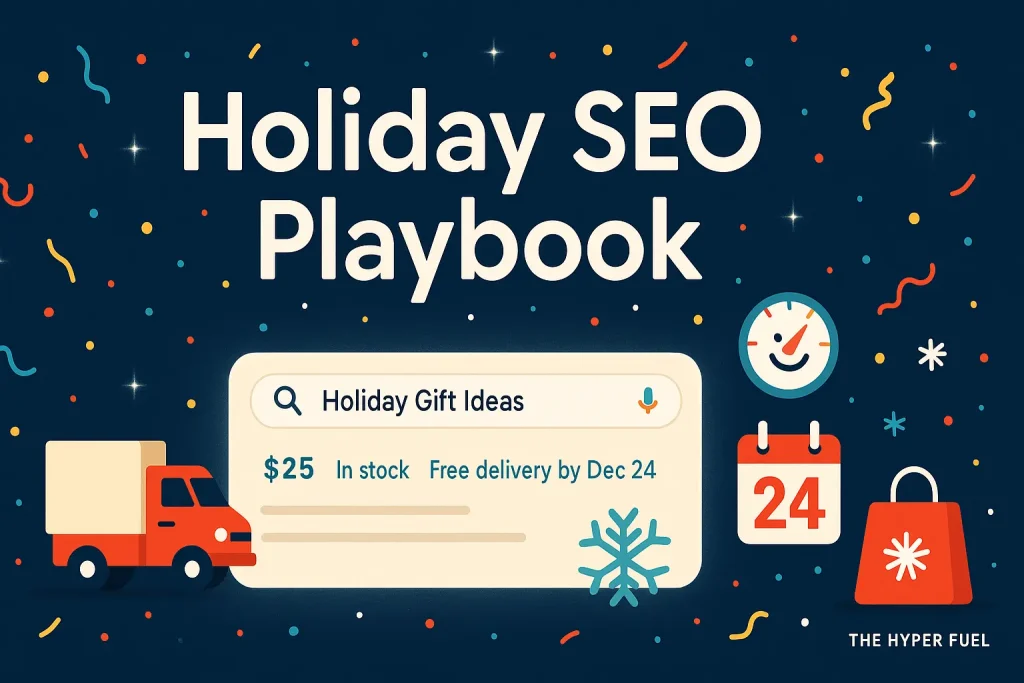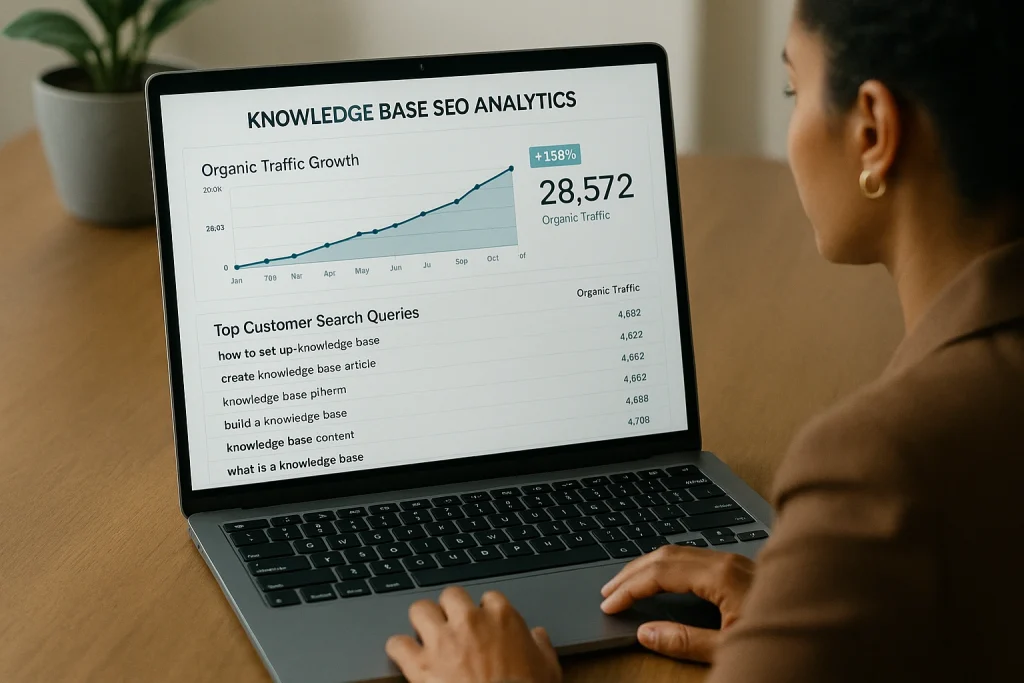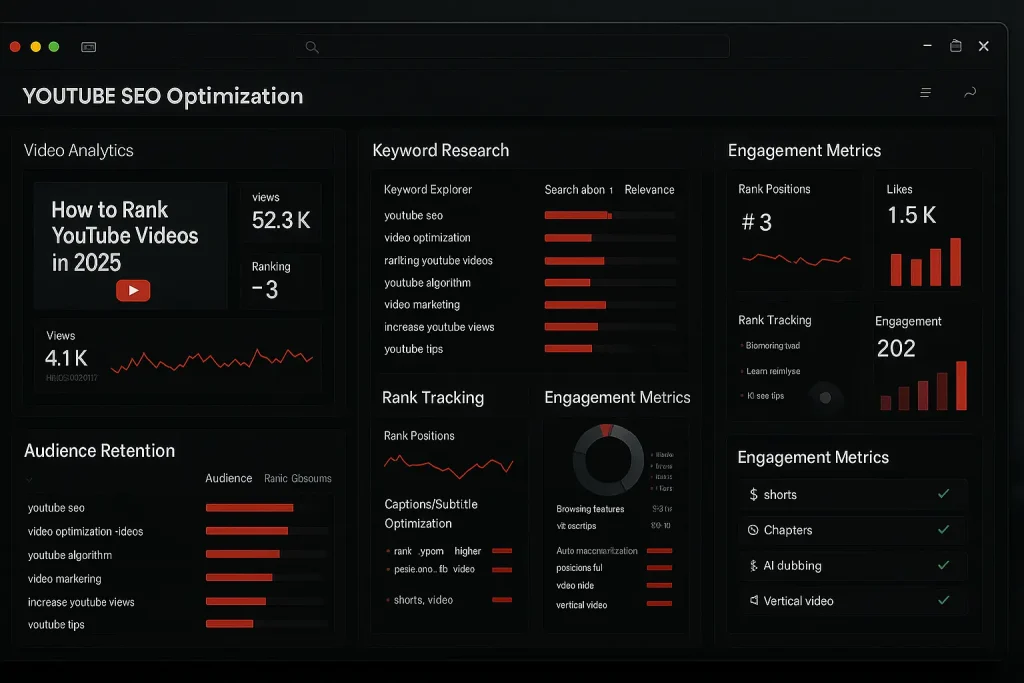Holiday SEO is your fourth quarter insurance policy, paid out in traffic, trust, and transactions.

If your organic engine idles in October, you do not have a traffic problem, you have a planning problem. The good news, you can still win meaningful revenue with focused moves that match how people search, how Google renders results, and how real buyers decide. The better news, great holiday SEO creates compounding assets that also lift January through March when everyone else is nursing a hangover.
Here is the playbook I use when a CEO asks for lift before Black Friday, a CFO asks for efficiency when CAC climbs, and a CMO needs proof that content can close. I call it runway and last mile of christmas marketing. One builds compounding search demand, the other captures shoppers who are ready to swipe.
Holiday SEO works because it pairs intent math with conversion clarity. If we speak the buyer’s language, earn a visible result, and remove friction on the page, we get paid. Simple idea, specific execution.
What changed in search this year, and why it matters for holiday SEO
Two realities shape 2025.
- Google cut back vanity rich results and now rewards clean product data, fast pages, and helpful content. FAQ and HowTo snippets are limited for most sites, so stuffing pages with markup that no longer surfaces is wasted effort. Prioritize results that still move the needle, product rich results, merchant listings, deals, local pack, and strong standard snippets.
- Speed and stability matter more. INP is now a Core Web Vital, so sluggish interactions tank rankings and conversions. Treat performance like merchandising. If your product grid jitters or your cart lags, your traffic will be expensive and your bounce rate will sing.
Practical translation for holiday SEO, ship content that answers real queries, mark up products and policies correctly, make the experience smooth on every tap, and invest where Google still gives you visual real estate.
Runway and last mile, the two-track plan for holiday SEO
Holiday SEO has two clocks. One runs on compounding time, the other runs on decision time.
The runway, build intent before the sale days
This is your content and discoverability lane.
- Gift-giver intent beats gamer slang. During holidays, the searcher is often a parent, a partner, a boss. Queries shift from “best RPG 2025” to “is Elden Ring appropriate for a 13 year old” or “quiet mechanical keyboard for office gift under 100.” Write for the gift-giver’s questions, not only the fan’s jargon. Create quick explainers, ratings context, fit and sizing guidance, age gates, alternatives, bundles, and comparison tables.
- Own the evergreen plus seasonal spikes. Map evergreen category hubs to long-life demand, then add holiday collections and guides that spike in November and December. Examples, “winter running shoes for icy sidewalks,” “carry-on suitcases that fit Delta overhead bins,” “non-alcoholic host gifts under 50.”
- Publish with a POV. If your holiday guide reads like a thin affiliate round-up, you will compete on price alone. Add operator notes, who it is for, who it is not for, what breaks, what to pair it with, returns gotchas. People buy clarity.
- Turn reviews into search assets. Mine customer reviews and support tickets for language real buyers use. If they say “itchy tag,” “battery door loose,” or “sizing runs small,” address it on the product page. Your best keywords are already in your inbox.
- Refresh winners with holiday overlays. Update last year’s top performers with 2025 models, new angles, and fresh internal links. Do not nuke URLs that rank. Extend them.
The last mile, capture demand during the surge
This is your conversion and SERP real estate lane.
- Title and meta tests pay like ads. Small shifts in phrasing can raise CTR by double digits. Use quick PPC tests to validate the winning language, then mirror it in organic titles and descriptions. Ship changes, watch Search Console, keep the winners.
- Deals and policy clarity win the click. Show shipping cutoffs, returns windows, and pickup options in the snippet with structured data and in Merchant Center. Buyers crave certainty, tell them exactly how this will arrive and how easy it is to send back.
- Local matters for last-minute shoppers. If you have stores or partners, your Google Business Profile needs correct holiday hours, in stock signals if available, and a sane pickup flow. Someone is searching “toy store near me open late,” be the answer.
How to capture gift-giver intent
Gift-givers type differently. They search by concern, by price band, by relationship, by age. Your job is to translate product-speak into human-speak.
- Queries by concern. “Age appropriate,” “screen time,” “sugar free,” “safe for airline travel,” “leave no residue,” “hypoallergenic.” Build FAQ blocks and scannable copy that answer these directly on the page. Avoid burying answers in PDFs or modal windows.
- Queries by price. “Under 25,” “under 50,” “premium,” “luxury,” “best value.” Create filterable collections and include price language in H2s and body copy where natural. Use product schema so the price renders in search.
- Queries by relationship. “For dad who grills,” “for team secret santa,” “for girlfriend who runs marathons,” “for remote team.” Curate. Do not try to be everything for everyone. Specificity sells.
- Queries by age and fit. “For 8 year old,” “for toddler room,” “for seniors with arthritis.” Add age ranges, dimensions, weight, sizing translations across US and EU, and simple fit finders. Show it in images and text.
- Queries by alternative. Not everyone gets the game they asked for. Offer swaps. “Like AirPods, not AirPods,” “like Stanley tumbler, slimmer grip,” “like Ooni, electric balcony friendly.” This is where you steal demand from sold out competitors.
Use your on-site search data to validate these patterns, then mirror the language in your copy. If internal search calls it “puffer jacket short,” do not title the category “cropped insulation outerwear.” Speak like a buyer.
SERP features worth playing for in 2025
You cannot win every box on the page. You only need the boxes that move product.
- Product rich results. Mark up product pages with
Product, include price, availability, ratings, shipping, and returns. Keep data consistent with Merchant Center to avoid mismatches. Aim for the snippet that shows price, stock, and a clean rating count. That snippet earns a click from a serious buyer. - Merchant listings and promotions. Use Merchant Center promotions and sale events for Black Friday, Cyber Monday, Green Monday, and post holiday clearance. Submit early, keep copy accurate, track performance with custom labels. Promotions show as “special offer” links, they lift CTR when buyers compare.
- Deals surfaces and price insights. Where possible, feed accurate historical pricing and clear markdowns. If your price truly beats the market, Google will show it. If your price does not beat the market, anchor with bundles or value adds like free engraving or same day pickup.
- Local pack and maps. For brands with stores or stockists, verify NAP consistency, special hours, and product highlights. Add photos that show giftable displays and pickup signage. The searcher who needs it today converts at a different clip.
- People Also Ask. Treat PAA as a research focus group. Pull recurring questions into your copy and answer them crisply. Your FAQ section is not fluff, it is a conversion asset and a keyword magnet.
Technical performance that earns money, not just scores
Performance sells. Fast interaction reduces cart abandonment, stable layouts keep the click. Aim for Core Web Vitals targets that hold up on midrange phones and spotty hotel Wi Fi.
- INP. Keep Interaction to Next Paint under 200 ms. Focus on input handlers, third parties, and long tasks. Defer or remove JavaScript that is not directly tied to the buyer task. Use native browser features before shipping a framework add on.
- LCP. Keep Largest Contentful Paint under 2.5 s. Preload hero images and critical fonts. Avoid carousels on product lists, one strong image loads faster and tests better.
- CLS. Keep Cumulative Layout Shift under 0.1. Reserve space for images, ads, reviews, and sticky bars. Nothing kills trust like a page that jumps while a shopper is about to tap Add to Cart.
- Images. Serve next gen formats, set width and height, lazy load non critical assets. Alt text should sell the click, not stuff keywords. One image, somewhere on the page, can carry an alt like “holiday SEO gift guide banner” to cover accessibility and relevance.
- Tracking. Reduce client side bloat. If your analytics, chat, and testing scripts make the site 30 percent slower, your insights are lying to you. Speed is a channel.
On page moves that lift CTR in a week
Titles and descriptions do more than rank, they stage the sale. Treat them like ads.
- Write to a specific buyer. “Suitcases for tall travelers, wheels that do not wobble,” will beat “Premium luggage collection” in December. Specific beats fancy.
- Lead with the winning angle. If returns and shipping timelines drive decisions in your category, lead with them. “Free 60 day returns, order by Dec 20 for delivery” earns the scroll.
- Mirror paid winners. Run a small exact match test on a head term, rotate 3 headlines, move the winner into your organic title. Keep doing it. The market will tell you what language pulls.
- Earn the bolded match. Put the exact phrase your buyer searches in the front of the title where it fits. Use the colon like a scalpel, not a crutch.
Learn more about our Conversion Rate Optimization services!
Merchant hygiene that removes friction
Your snippet can promise the world, your back end needs to keep the promise.
- Shipping cutoffs. Publish clear order by dates per region. Use structured data and Merchant Center shipping settings to echo the promise in search.
- Returns and exchanges. Mark up returns policies so “Free 60 day returns” shows in your snippet. Make the process painless and show it above the fold on PDPs.
- Inventory reality. Hide out of stock from holiday collections, offer waitlists, auto suggest alternatives. Nothing burns a shopper faster than a dead end.
- Payments and financing. Surface pay in four options, but hide it when the AOV is tiny. Do not slow the cart to brag about payment logos.
Content that sells without sounding like SEO
The best holiday SEO reads like a great retail associate. Helpful, specific, not pushy.
- Cheat sheets win. Short tables with size conversions, voltage, compatible models, or care instructions reduce returns and capture long tail. They also get scraped into featured displays when you are lucky.
- Comparisons reduce anxiety. Side by side guides for Good, Better, Best let a buyer pick a lane. Offer a budget and premium option. Tell them who each is for.
- Bundles that make sense. Pre build add ons that actually belong together. Camera plus extra battery, gloves plus glove liners, gaming console plus second controller. Bundle pages can rank on their own if you write them to answer a real query.
- Human photos. Show scale and use, not just product on white. If your customer is buying for someone else, help them visualize how it fits.
Measurement that proves content closes
Traffic that does not convert is a cost center. Traffic that converts funds your Q1.
- Use Search Console to spot breakout queries. Sort by change, not just total clicks. If “best budget cordless drill under 100” pops in November, give it a landing page.
- Build a holiday watchlist. Track top 50 terms by rank, CTR, and revenue. Update titles on the ones that have rank but low CTR. Update content on the ones that have CTR but low conversion.
- Attribute like an operator. Tie organic landing pages to assisted revenue in your analytics, not just last click. Holiday buyers toggle between devices and tabs. If your blog post sparks the comparison and your PDP closes, both did their job.
Holiday SEO checklist you can actually implement in one week
- Refresh 10 proven pages with current models, shipping cutoffs, and internal links to holiday collections.
- Create 5 gift landing pages built around price bands and relationships, include real customer quotes.
- Mark up top products with complete
Productschema, shipping, and returns. - Submit active promotions in Merchant Center, test one percent off style that fits your margin.
- Update Google Business Profile holiday hours and pickup instructions.
- Run a micro PPC test to validate the best headline and value prop for two head terms, mirror the winners in organic titles and meta descriptions.
- Compress and preload hero images, audit Core Web Vitals, fix your worst long tasks.
- Add a last chance bar sitewide with order by dates and store pickup, measured for impact, not vibes.
FAQs
Holiday SEO is the practice of tailoring your organic strategy for November and December search behavior, then turning those assets into evergreen revenue. It matters because intent, SERP layouts, and conversion friction shift in Q4. When you match that shift, you win higher intent traffic and convert it at a better rate.
Start in August to build runway and compounding authority. If it is already late, you can still ship last mile moves this week, title tests, Merchant promotions, shipping and returns markup, and performance fixes that directly raise CTR and conversion.
Lead with buyer language, not brand terms. Gift giver queries by concern, price, relationship, age, and alternatives. Use your on site search and support tickets to collect phrases, then validate with Trends and Search Console. Build landing pages for the winners.
Classic FAQ rich results are limited for most sites, so do not expect drop downs to always appear. Keep FAQs anyway because they answer real buyer questions, they earn People Also Ask visibility, and they help your snippet copy.
Add accurate shipping and returns information through structured data and Merchant Center settings. Keep the promise consistent in your snippet and on your product pages.
INP for responsiveness, LCP for load, CLS for stability. Fix long tasks, preload hero assets, and reserve space for dynamic elements. Small wins here generate real cash.
A clear angle, who it is for, price band, three to five products with honest pros and cons, returns notes, and a quick comparison table. Add customer quotes and photos that show scale and use.
Publish dedicated sale pages early, keep the URL stable year to year, link them from your nav during the event, and feed promotions to Merchant Center. After the event, redirect to a deals hub so links keep compounding.
Update holiday hours in your Google Business Profile, add pickup instructions, add photos of gift displays, and use product highlights. Then build a simple local landing page for each store with unique inventory callouts.
Update titles and descriptions on pages that already rank, mark up shipping and returns, submit live promotions, and fix obvious performance drags. These moves raise CTR and conversion without waiting months.
Yes in details, similar in principle. Honor regional shipping cutoffs, returns rules, and price display norms, for example VAT inclusive pricing in the EU. Keep the structure the same, adapt the copy and policy specifics per country.
AI elements influence some queries, but shoppers still click product listings, local packs, and strong blue links. Focus on product data quality, clear policies, and content that answers precise questions. That mix keeps working.
The close
If you remember one thing, remember this. Holiday SEO is not a bag of hacks, it is a clean promise, delivered fast, to the exact person who is searching. Ship the runway, ship the last mile, and the math will take care of itself.
Friendly next step, pick three moves from the checklist and put them on today’s calendar. If you want a second set of hands, I can help you ship.




